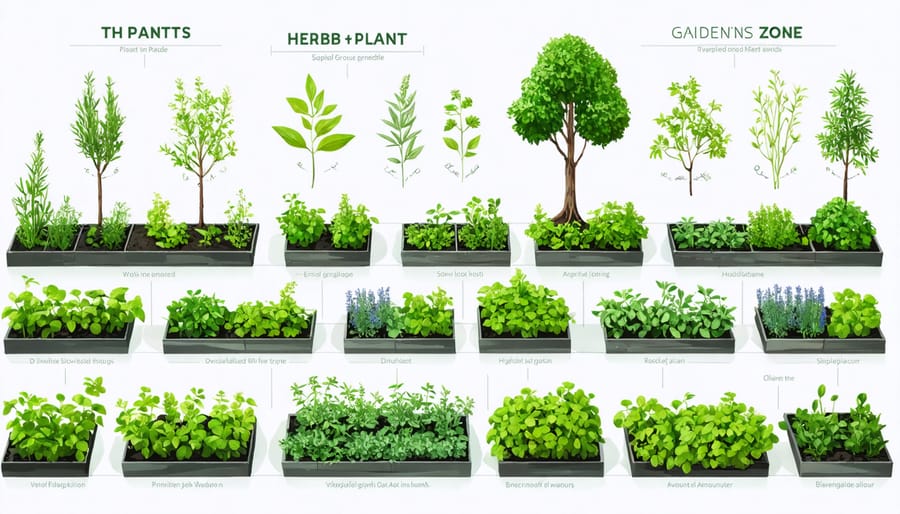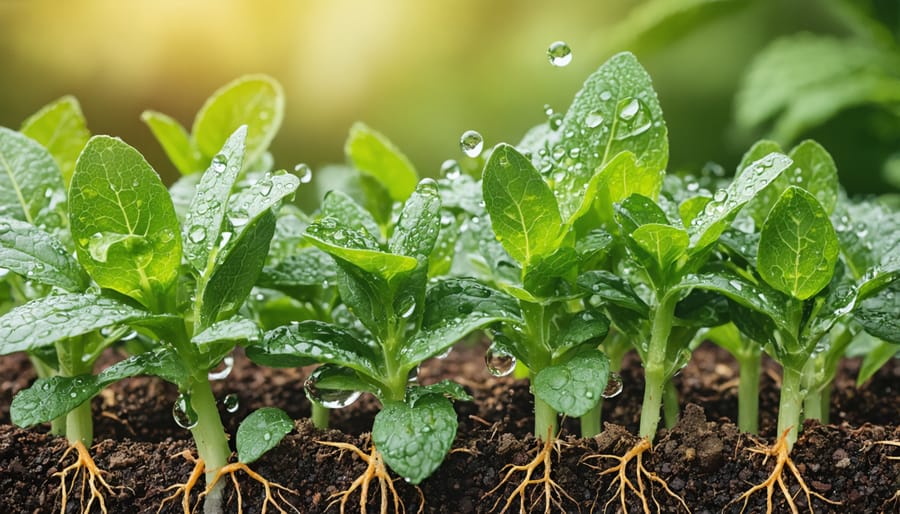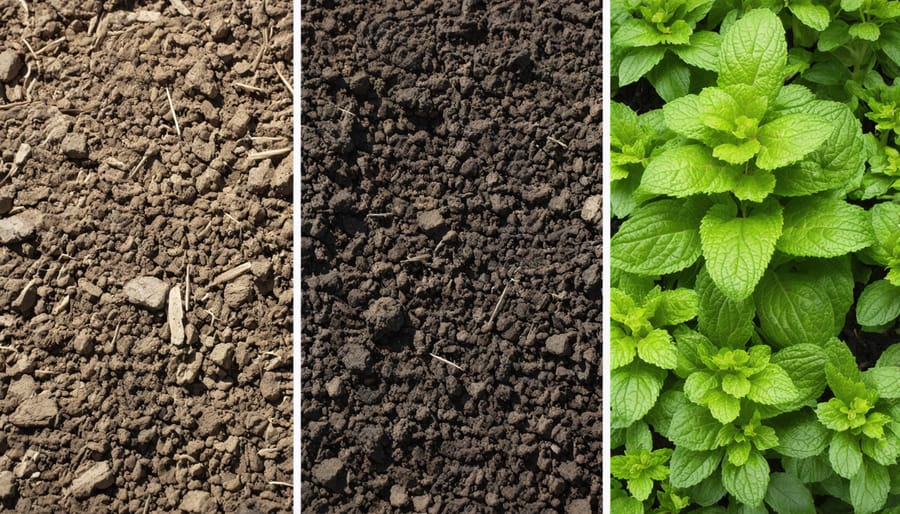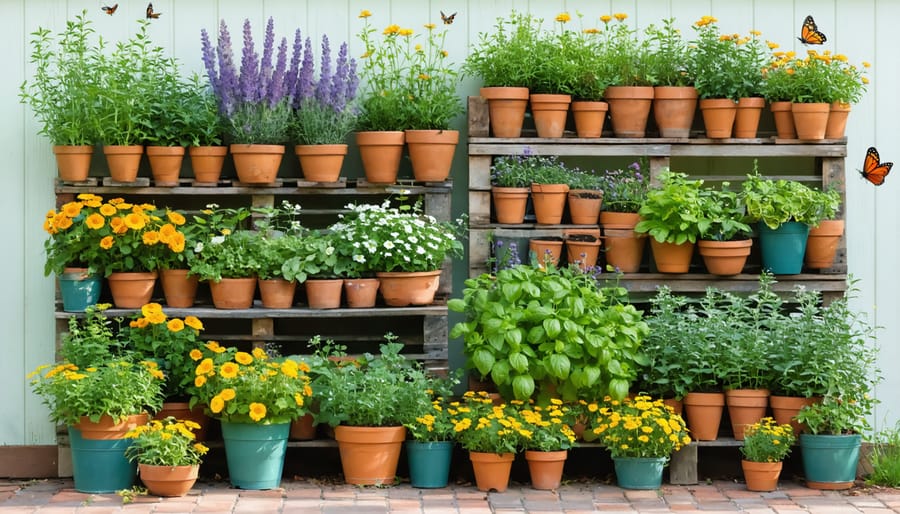Water management stands at the forefront of sustainable gardening, offering both environmental benefits and significant cost savings for home gardeners. By implementing smart water conservation techniques, we can maintain thriving herb gardens while protecting our most precious natural resource. From ancient rainwater harvesting methods to modern drip irrigation systems, sustainable water practices have evolved to meet the growing challenges of climate change and water scarcity.
Today’s gardeners face a crucial challenge: maximizing plant health while minimizing water waste. The good news? Simple, effective solutions exist that transform traditional water-hungry gardens into water-wise oases. Whether you’re growing culinary herbs in a compact urban space or maintaining an extensive herb collection, sustainable water management practices can reduce your water consumption by up to 50% while promoting healthier, more resilient plants.
This guide explores proven strategies for efficient water use, from soil preparation and mulching techniques to automated irrigation systems and drought-resistant plant selection. By adopting these practices, you’ll not only create a more sustainable garden but also develop a deeper connection to the natural water cycles that sustain all life. Let’s dive into the practical steps that will help you become a more responsible steward of this essential resource.
Design Your Herb Garden for Maximum Water Efficiency
Group Plants by Water Needs
Organizing your herbs based on their water needs is a game-changer for sustainable gardening. Think of it as creating little neighborhoods where plants with similar thirst levels can thrive together. This smart grouping technique, often called hydrozoning, makes watering more efficient and helps prevent both over- and under-watering.
Start by dividing your herbs into three main groups: high, moderate, and low water users. Moisture-loving herbs like mint, basil, and parsley should be planted together in areas that retain water well. These herbs typically need consistent moisture and will thank you with lush, abundant growth when their water needs are met.
In your moderate-water zone, place herbs like oregano, thyme, and chives. These adaptable plants prefer their soil to dry slightly between waterings but still need regular moisture to produce flavorful leaves. They’re perfect for the middle ground of your garden.
Finally, create a low-water zone for drought-tolerant Mediterranean herbs like rosemary, sage, and lavender. These tough plants actually prefer drier conditions and will reward you with better flavor when not overwatered. Plus, they’re perfect for those hot, sunny spots in your garden.
By grouping plants this way, you’ll save water, time, and energy while ensuring each herb gets exactly what it needs to flourish. Remember to adjust your irrigation system or watering routine to match each zone’s specific requirements.

Create Water-Smart Planting Zones
Creating water-smart planting zones is one of the most effective ways to manage water usage in your garden. By grouping plants with similar water needs together, you’ll not only save water but also create a more efficient and thriving garden space. When combined with smart edible landscaping techniques, this approach can transform your garden into a sustainable oasis.
Start by mapping your garden’s natural moisture zones. Notice where water naturally collects, which areas dry out quickly, and where you get the most sun exposure. Use these observations to create three distinct hydrozones:
1. High-water zone: Place moisture-loving herbs like mint, watercress, and parsley in areas that naturally retain water or near downspouts.
2. Moderate-water zone: Group herbs like basil, cilantro, and chives together in areas with average moisture needs.
3. Low-water zone: Reserve sunny, well-draining spots for drought-tolerant herbs such as sage, thyme, and rosemary.
Consider using circular or curved garden beds instead of straight rows, as they naturally create micro-climates that help retain moisture. Place taller plants on the west or south sides to provide shade for more delicate herbs, reducing their water needs. Add mulch between plants to minimize evaporation and maintain soil moisture.
Remember to position high-water plants at the lowest point of your garden, allowing excess water to naturally flow toward them while keeping drought-resistant plants in elevated areas.
Smart Irrigation Methods for Herb Gardens
Drip Irrigation Systems
Drip irrigation is one of the most efficient ways to water your garden, delivering moisture directly to plant roots while minimizing waste. Setting up a basic drip system might seem daunting at first, but it’s actually quite straightforward and can reduce your water usage by up to 70% compared to traditional watering methods.
Start by connecting your main water line to a pressure regulator and filter – these essential components ensure your system works effectively and prevents clogging. From there, run your main line (½-inch tubing) along your garden beds. Connect smaller ¼-inch lines with emitters to deliver water precisely where needed. Place emitters about 12 inches apart for herbs and vegetables, adjusting based on your soil type and plant spacing.
For best results, cover your drip lines with mulch to prevent evaporation and protect the tubing from sun damage. This also helps maintain consistent soil moisture and reduces weed growth. Consider installing a timer to automate your watering schedule – this not only makes maintenance easier but ensures your plants receive consistent irrigation.
Regular maintenance is simple but crucial. Check your system monthly for leaks or clogged emitters. Flush the lines every few months by removing end caps and running water through to clear any debris. During winter, drain the system completely to prevent freeze damage.
A well-maintained drip system can last for years, making it a worthwhile investment for any garden. Plus, you’ll save countless hours of hand-watering while giving your plants exactly what they need to thrive.

Self-Watering Solutions
Self-watering systems are game-changers for busy gardeners looking to maintain healthy herbs while conserving water. Whether you’re interested in container herb gardening or have a larger outdoor space, there are solutions for every setup.
For DIY enthusiasts, creating your own self-watering planter is both rewarding and cost-effective. The classic two-container method involves nesting a perforated upper container inside a water reservoir, connected by a wick system made from cotton rope or fabric. This setup allows plants to draw water as needed, preventing both over- and under-watering.
Commercial options have evolved significantly in recent years. Modern self-watering containers feature built-in water level indicators, making it easy to monitor when it’s time to refill. Sub-irrigation planters, which water plants from the bottom up, are particularly effective for herbs that prefer consistent moisture levels.
For those with multiple containers, drip irrigation systems with timers offer an efficient solution. These can be connected to rain barrels, creating a sustainable cycle that makes the most of natural rainfall. Smart irrigation controllers take this a step further by adjusting watering schedules based on weather conditions and soil moisture readings.
One of my favorite solutions is the ollas system – buried clay pots that slowly release water directly to plant roots. This ancient technique is perfect for herb gardens, as it delivers water precisely where it’s needed while minimizing evaporation. Plus, it’s a wonderful conversation starter when fellow gardeners visit!
Water Conservation Techniques
Mulching Strategies
Mulching is one of the most effective ways to conserve water in your herb garden while suppressing weeds and maintaining soil health. A good 2-3 inch layer of mulch can reduce water evaporation by up to 70%, making it a game-changer for sustainable gardening.
For herb gardens, organic mulches work particularly well. Straw is an excellent choice, as it’s lightweight and allows proper air circulation. Just make sure it’s seed-free to avoid unwanted sprouts. Wood chips and bark are other fantastic options, breaking down slowly to improve soil structure over time. For a cost-effective solution, shredded leaves make wonderful mulch and help recycle garden waste.
When applying mulch, always keep it about an inch away from plant stems to prevent rot. Start with clean, weed-free soil, and water thoroughly before laying down your mulch. This initial watering helps lock in moisture and gives your herbs a good start.
For Mediterranean herbs like rosemary and thyme, consider using gravel or pebble mulch. These herbs prefer drier conditions, and mineral mulches help replicate their natural habitat while controlling moisture levels. As a bonus, they look absolutely stunning in the garden!
Remember to refresh your organic mulch periodically as it breaks down – typically once or twice a year. This ongoing maintenance ensures continuous water conservation and soil improvement benefits.

Rainwater Harvesting
Collecting rainwater is one of the most rewarding ways to care for your garden while conserving precious resources. A basic rainwater harvesting system starts with your roof and gutters, which act as natural collection surfaces. By adding a downspout diverter and connecting it to a storage barrel, you can capture hundreds of gallons of free, natural water throughout the rainy season.
The most common setup uses a 55-gallon food-grade barrel positioned beneath your downspout. Make sure to place it on a sturdy, level surface – I like using concrete blocks or a dedicated stand. Add a mesh screen at the top to keep out leaves and debris, and install a spigot near the bottom for easy access to your stored water.
For those ready to scale up, connecting multiple barrels in series allows you to store even more water. Simply link them with short sections of pipe at the top, creating an overflow system that fills each barrel in sequence. Consider adding a small pump if you need to move water uphill or want to connect it to a drip irrigation system.
Remember to maintain your system by cleaning the gutters regularly and checking the screens for buildup. In winter, either empty the barrels or install freeze-proof spigots to prevent damage. Your plants will love the natural, chlorine-free rainwater, and you’ll notice the difference in both your water bill and your garden’s health.
Soil Moisture Management
Maintaining optimal soil moisture is a cornerstone of smart soil management and plays a crucial role in water conservation. The key lies in creating a balanced environment where your plants get exactly what they need, no more and no less.
Start by incorporating organic matter like compost into your soil, which acts like a sponge to retain moisture while improving drainage. A 2-3 inch layer of mulch on top of your soil works wonders too – it reduces evaporation, keeps roots cool, and helps maintain consistent moisture levels throughout the day.
Get to know your soil’s moisture level by using the simple finger test: stick your finger about an inch into the soil. If it feels dry at that depth, it’s time to water. For more precise measurements, consider investing in a soil moisture meter, which takes the guesswork out of watering decisions.
Group plants with similar water needs together, and consider using water-retaining products like water-storing crystals or coconut coir in your soil mix. These materials slowly release moisture to plant roots as needed, reducing the frequency of watering while keeping your plants happy and healthy.
Remember to water deeply but less frequently, encouraging roots to grow deeper and become more resilient to drought conditions. This approach helps create stronger plants while using less water overall.
As we wrap up our journey through sustainable water management practices, remember that every drop counts in creating a more environmentally conscious garden. By implementing the techniques we’ve discussed, you’re not just saving water – you’re contributing to a healthier planet while growing thriving herbs and plants.
From designing smart irrigation systems to selecting drought-resistant herbs, each step you take makes a significant difference. The beauty of these practices lies in their simplicity and adaptability. Whether you’re tending to a small balcony garden or managing an extensive herb plot, these water-wise methods can be scaled to suit your needs.
Remember to start small and build gradually. Perhaps begin with mulching and proper soil preparation, then progress to installing a rainwater harvesting system as you become more confident. The key is to make sustainable practices part of your daily gardening routine rather than viewing them as occasional tasks.
The results of implementing these practices extend beyond water conservation. You’ll likely notice stronger, more resilient plants, reduced maintenance time, and lower water bills. Many gardeners report that their herbs develop more concentrated flavors when grown using water-wise techniques – a delightful bonus for your culinary adventures!
As our climate continues to change and water becomes an increasingly precious resource, your efforts in sustainable water management become even more valuable. Share your experiences with fellow gardeners, learn from each other, and continue to explore new ways to conserve water in your garden.
Remember, sustainable gardening is a journey, not a destination. Each season brings new opportunities to refine your practices and discover innovative ways to work with nature rather than against it. Your commitment to water-wise gardening not only benefits your garden but also inspires others to follow in your footsteps.
Let’s continue growing together, one water-wise choice at a time. Happy gardening!




